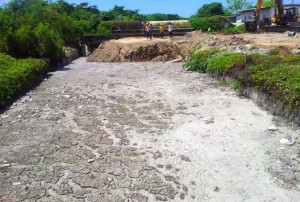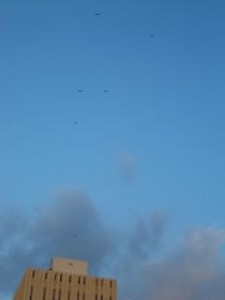
Clean Kingston Harbour?
May 11th, 2019
Why the question mark? Because I wonder if a clean Kingston Harbour is possible. An exclamation mark might be more optimistic. Let’s order people to get together and make it happen! However, the topic of the GraceKennedy Foundation Lecture on April 3 was devoid of punctuation. It also had a subtitle: Pipe Dream or Pot of Gold? At this point, I would rather say the former; or perhaps, neither, because it is far too late.
So, a few weeks ago I attended this high-profile annual event. Now that the company that funds the lecture has built a quite beautiful new building (all lit up at night) right on the waterfront (sea level rise, anyone?) it seemed appropriate that Kingston Harbour was up for discussion. Or specifically, how to clean it.
It was a very full house at the Jamaica Pegasus. Loud and squeaky tiered stands were provided for the overflow, which latecomers tried in vain to quietly tiptoe onto! This year, the lecture was in panel discussion format; not a very good decision, I thought. We have enough panels. Although all panelists ably carried out what they had been asked to do, the message (or messages) became fragmented. Professor Dale Webber – a man who wears several substantial hats, these days – was a genial moderator, as always. His wife Professor Mona Webber was a panelist, along with Tijani Christian of the Commonwealth Youth Council and Director General of the Planning Institute of Jamaica Wayne Henry.
It was impressed on us that the GK Foundation’s core values include a “commitment to sustainable development,” which I hadn’t really been aware of. The Foundation sees its role here as “brokers, without charging a fee,” noted Foundation Chairman Fred Kennedy. This is laudable, but to me sounded a touch tentative. GK is a large company by Jamaican standards, but there is only so much it can do.
Professor Mona Webber described the harbor as “in many ways a national treasure.” It covers approximately 51 square kilometers (including Hunts Bay, which is shallower, almost always silted and often clogged with plastics) and is the seventh deepest natural harbor in the world. It is hard to imagine, but it was once completely ringed with mangroves (Professor Webber loves mangroves). A survey this summer will determine how much of the seagrass beds remain; they have been greatly damaged by dragging fishing nets across the bottom; nowadays, these nets capture more plastics than fish). Although restoration efforts are underway (the cleaning of Refuge Cay, for example, an important seabird nesting site, which is now filling up with garbage again) – restoration cannot always be an effective substitute for conservation. We need to preserve what we have got!

Layers of garbage in Refuge Cay in the Palisadoes mangroves, a few years ago. It has since been cleaned but the garbage is returning. This is a Ramsar Wetland of International Importance. (My photo)
There was a loud gasp in the audience when Professor Webber said in a clear, firm voice: “The waters of the Kingston Harbour should not be in contact with human skin.” Moreover, this has been so since the late 1970s – nothing new! We still see boys diving in and splashing around, on a daily basis; I suppose some consider the waters clean enough. No, they are not. The harbor has a relatively narrow entrance and is filled with too many nutrients – that is, mostly untreated sewage from the 19 gullies that drain into it; the catchment area for these gullies is quite large, extending back as far as Ewarton, St. Catherine. All of that goes into the stressed-out harbor.
The PIOJ Director described the harbor as “natural capital” that we are not taking advantage of. It has “direct and indirect use value.” Now, I hope I got these numbers right, but its gross value added direct use went from J$70.4 in 2008 to $171.5 billion in 2017. In terms of shoreline protection, its value was US$510 million in 1997.
Then we have to talk about our garbage disposal systems, which are “overwhelmed,” panelists concluded. There are over 2.6 million pieces of microplastics per square kilometer in the harbor, according to studies. Doing the Math, that is over 132 million pieces of plastic in Kingston Harbour. This is a threat to fisheries, shipping – and public health.
Two things I found notably missing in the discussion: Firstly, there was zero mention of climate change; only the economic impact of Hurricane Ivan was noted. Secondly, the industrial pollution of the harbor was barely mentioned. I have myself seen the gullies filled with liquid, stinking chemicals in Seaview Gardens, draining into the sea from certain large companies on Spanish Town Road. I suppose we didn’t want to upset the business leaders who were there. (I am told that sometimes the effluent in the gullies is hot!)

Industrial waste in the middle of a residential community in Seaview Gardens. In the background there appear to be efforts to stop it from flowing into the harbor. (My photo)
So, Mr. Tijani Christian, if we are talking about the social and human aspects of Kingston Harbour, let’s also consider the pollution flowing from land into the sea, and how it affects our less prosperous communities. Children have fallen into those toxic gullies. We have to discuss reviving residential areas like Rae Town and Seaview Gardens that border the harbor – and making them liveable. Great efforts are being made to repair and brighten up downtown Kingston (which still, however, has a major “informal garbage dump” problem!) but that is only a small part of what needs to be done. Correctly, though, Mr. Christian pointed to the need for a strengthened rule of law, lack of enforcement of laws that affect people’s quality of life, “individualistic behavior” – and critically, weak town planning.
Congratulations to Caroline Mahfood, the tireless and highly efficient Executive Director of the GraceKennedy Foundation, who was behind the scenes. If the Foundation “has begun plans to form partnerships with civil society,” as Chairman Kennedy noted, then I hope it will be sooner, rather than later. There is much work to be done, and we all know that collaboration is critical. So are huge injections of cash (from where?) to fix the problem – not only the waters themselves but what is happening on the land.
Kingston Harbour is indeed a national treasure – but one that is badly tarnished. Can we collectively afford to do anything about it?
Tags: Caroline Mahfood, Climate Change, downtown, fisheries, Fred Kennedy, garbage disposal, GraceKennedy Foundation, gullies, Hunts Bay, Kingston Harbour, land-based pollution, mangrove, microplastics, Planning Institute of Jamaica, plastic pollution, Professor Dale Webber, Professor Mona Webber, Rae Town, Refuge Cay, seabirds, seagrass beds, Seaview Gardens, solid waste, sustainable development, Tijani Christian, waterfront, Wayne Henry
The Gleaner reserves the right not to publish comments that may be deemed libelous, derogatory or indecent.
To respond to The Gleaner please use the feedback form.
One Response to “Clean Kingston Harbour?”
- We Are the Zoomers
- Living Online with Humans and Birds: NAOC 2020
- Human Trafficking and the Problem of Public Education
- Down Memory Lane
- Are We Ready to Recover from COVID-19?
- Road Safety Matters: Is Your Vehicle Safe?
- Sexual Harassment, Me Too, and the Minister’s Disturbing Giggle
- The Vulnerable Senior Citizens, Private Care Homes and COVID-19
- A Muddle Over Masks
- Here is Something Life-Saving You Can Do: Give Blood!





[…] impacts our marine environment, quite quickly. As I noted recently, it will actually cost billions to tackle Kingston Harbour, with its sixteen gullies – and to tackle it on land and […]